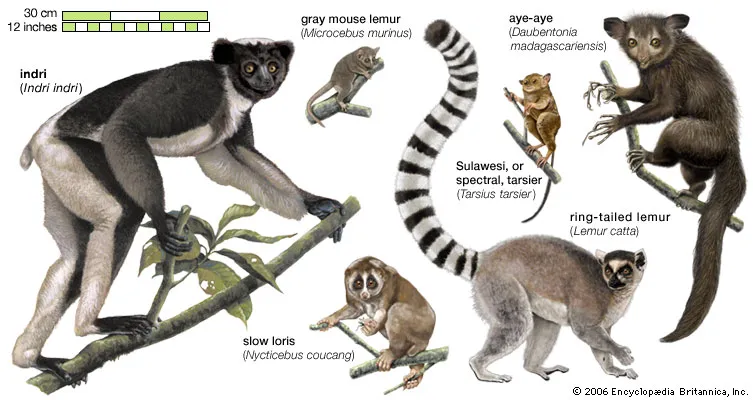In the diverse world of primates, lemurs stand out not only for their unique appearance and behavior but also for their crucial role in their ecosystems. Native exclusively to Madagascar and the Comoros Islands, lemurs are fascinating creatures whose survival is intricately tied to the health of their environment. This article delves into the world of lemurs, exploring their ecological importance, the challenges they face, and the efforts being made to ensure their conservation.
The World of Lemurs
Lemurs belong to the suborder Strepsirrhini, which distinguishes them from other primates like monkeys and apes. They are characterized by their large eyes, keen sense of smell, and a distinctively wet nose or rhinarium, which is used to detect scents. Lemurs are arboreal, meaning they spend most of their lives in trees, and their specialized adaptations make them well-suited for life in the dense forests of Madagascar.
- Species Diversity
There are nearly 100 species of lemurs, ranging in size from the tiny mouse lemur, which is about the size of a large mouse, to the large indri, which can reach up to 3 feet in length. The diversity among lemur species reflects their adaptability to various habitats, including rainforests, dry deciduous forests, and spiny forests. Each species has unique behaviors and adaptations that contribute to the ecological balance of their respective environments.
- Behavior and Social Structure
Lemurs exhibit a wide range of social structures and behaviors. Some species, like the ring-tailed lemur, live in large, matriarchal groups, where females lead the social hierarchy. Others, such as the solitary aye-aye, are more reclusive and prefer to live alone. Lemurs are known for their complex vocalizations, which they use to communicate with one another, especially in dense forest environments where visual cues are limited.
- Ecological Role
Lemurs play a vital role in their ecosystems. As frugivores (fruit eaters) and herbivores, they contribute to seed dispersal and plant regeneration. By consuming and dispersing seeds, lemurs help maintain the health and diversity of Madagascar’s forests. Their foraging activities also influence the distribution of plant species, which in turn affects other wildlife.
Challenges Facing Lemurs
Despite their ecological importance, lemurs face numerous threats that jeopardize their survival:
- Deforestation
The most significant threat to lemurs is habitat destruction. Madagascar’s forests are being cleared for agriculture, logging, and mining. Deforestation not only reduces the available habitat for lemurs but also fragments their living areas, making it difficult for them to find food and mates. The loss of habitat has led to declines in lemur populations and increased vulnerability to extinction.
- Climate Change
Climate change poses an additional threat to lemur populations. Changes in temperature and precipitation patterns affect the availability of food resources and the health of their habitats. Increased frequency of extreme weather events, such as cyclones, also disrupts the delicate balance of Madagascar’s ecosystems.
- Illegal Wildlife Trade
Lemurs are also targeted by illegal wildlife trade. Some species are captured for the pet trade or for use in traditional medicine. The illegal wildlife trade not only threatens individual lemurs but also disrupts social structures and populations in the wild.
- Human-Wildlife Conflict
In some areas, lemurs come into conflict with local communities. As forests are cleared for agriculture, lemurs may enter agricultural fields in search of food, leading to crop damage. This can result in negative attitudes towards lemurs and further exacerbate conservation challenges.
Conservation Efforts
Given the threats facing lemurs, numerous conservation efforts are underway to protect these remarkable primates and their habitats:
- Protected Areas and Reserves
Establishing protected areas and reserves is a key strategy for conserving lemurs. Madagascar has created several national parks and reserves that safeguard critical habitats for lemurs and other wildlife. These protected areas help to preserve large tracts of forest and provide a refuge for lemur species.
- Community Engagement
Engaging local communities in conservation efforts is crucial for the success of lemur protection initiatives. Conservation organizations work with local communities to promote sustainable practices and reduce human-wildlife conflict. By involving communities in conservation planning and decision-making, these initiatives help to build support for lemur conservation.
- Research and Monitoring
Ongoing research and monitoring are essential for understanding lemur populations and their needs. Scientists conduct field studies to track lemur behavior, population dynamics, and habitat conditions. This research informs conservation strategies and helps to identify emerging threats.
- Education and Advocacy
Raising awareness about the importance of lemurs and their conservation is a critical component of conservation efforts. Educational programs and advocacy campaigns aim to inform the public about the threats facing lemurs and the actions they can take to support their protection.
- International Collaboration
Conservation organizations, governments, and researchers from around the world collaborate to address the challenges facing lemurs. International partnerships and funding support efforts to protect lemurs and their habitats. These collaborations help to coordinate conservation strategies and mobilize resources for on-the-ground initiatives.
Conclusion
Lemurs are extraordinary creatures whose survival is intricately linked to the health of Madagascar’s ecosystems. Their unique adaptations and ecological roles make them vital to the balance of their habitats. However, deforestation, climate change, illegal wildlife trade, and human-wildlife conflict pose significant threats to their existence.
Through concerted conservation efforts, including habitat protection, community engagement, research, and education, we can work towards securing a future for lemurs. By addressing the challenges they face and supporting conservation initiatives, we can help ensure that these remarkable primates continue to thrive in their natural habitats.
As we strive to protect lemurs and their ecosystems, we are not only safeguarding these fascinating primates but also preserving the rich biodiversity of Madagascar. The survival of lemurs serves as a reminder of the interconnectedness of all species and the importance of our collective efforts to protect the natural world.
